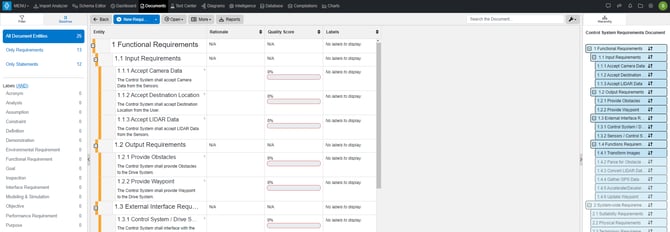Quality Check in Documents View (v4.9 and earlier)
Strengthen the quality of your requirements using Innoslate's Quality Check feature.
If you are using Innoslate 4.10 or later, please refer to the Quality Check in Documents (v4.10) article.
Users of Innoslate (in v4.9 and earlier) can conveniently assess the quality of their requirements by utilizing the Quality Check feature provided in Innoslate's Documents View. This feature employs Artificial Intelligence (AI) in the form of Natural Language Processing (NLP) to verify the quality of requirements within an Innoslate document.
Upon selecting 'Quality Check' under the 'More' dropdown, a Quality Score is given to Requirement entities only (not Statement entities). This feature checks for certain attributes to determine the Quality Score. While there are 8 attributes in total, the 'Quality Check' checks 6 of the 8, allowing for 75% as the highest score a requirement can receive from this feature.
By default in Documents View, the Quality Score column is displayed. Requirements that have not been scored yet will show a Quality Score of 0 percent. After running a Quality Check, this column displays the resultant percentage from 0 to 75 depending on the number of quality indicator attributes determined to be true via the automatic checks.
Built-In Quality Indicator Attributes
The Requirement class in Innoslate's database schema includes a set of attributes that are built-in for this feature. These attributes help assess the quality of requirements in an Innoslate document.
| Attribute | Description | Automated? |
|---|---|---|
| Clear | Explicit and not confusing to readers. | Yes |
| Complete | Expresses a whole, single idea, and not portions of one or many. | Yes |
| Consistent | Does not conflict with other requirements. | Yes |
| Correct | Describes the user’s intent and legally possible. | No |
| Design | Does not impose a specific solution (“what” not “how”). | Yes |
| Feasible | Implementable with existing or projected technology and within cost and schedule. | No |
| Traceable | Uniquely identifiable and able to be tracked to predecessor and successor lifecycle entities. | Yes |
| Verifiable | Proves within realistic cost and schedule that the architecture meets the requirement. | Yes |
The attributes of 'Correct' and 'Feasible' are not automatically included in the quality check. These attributes determine the legality and possibility of the requirement, respectively. In order to achieve a 100% score, users should select 'Yes' for these specific attributes.
Automatically Analyze All Requirement Entities
Here is an example of a document with requirements before running the Quality Check.

1. To run the Quality Check, click the More dropdown button in the Document’s toolbar and select 'Quality Check.'

3. Depending on the size of the document, a spinner may appear to indicate that the Quality Check function is in progress.
4. Once the Quality Check is complete, the Quality Score bar for each Requirement entity in the Document will be updated (with a maximum achievable score of 75 percent at this stage).
Below is an example of a document with it's requirement's Quality Score after running the Quality Check.

To understand why each individual requirement received its score, simply click on the requirement (indicated by the red arrow) and navigate to the Attribute Tab on the left sidebar (top red box on left sidebar) . Under the 'Quality Score' section, if an attribute is marked as 'No', you will find suggestions to enhance that particular attribute for the requirement (indicated with the red boxes to the left of the requirements).

It is important to keep in mind while doing this analysis, that these attributes are suggestions for improving your requirements. Ultimately, users have the flexibility to decide whether or not these suggestions are applicable to their specific Innoslate project. If desired, users can easily override a suggestion by selecting 'Yes' from the attribute's dropdown menu.

Upon changing an attribute, you'll find the score reflect the change:

To continue learning about Documents View, Click Here.
(Next Article: Documents View Navigation)
